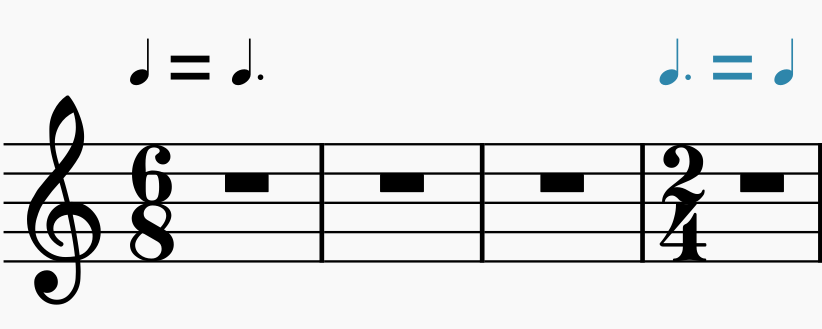So, I am writing a Scherzo in the key of Eb major for a string quartet. And I was just thinking about what to do for the B section of my Scherzo, both in key and time signature. I was thinking that for the time signature, I should maybe do a change from 2/4 to 6/8. Now I could just do that, keeping the quarter note speed at 160 quarter notes per minute and thus changing the tempo of the 6/8 section to 107 BPM. But, that is going to slow down the 6/8, possibly to the point where it feels like 6 beats rather than 2. I want to keep the tempo the same in the 6/8 section as in the 2/4 section, 160 BPM, so as to keep the feel of Allegro vivace going.
To do this, the speed of the quarter notes has to change to a faster speed. There are 3 ways I could convey this to the string quartet players. I'm not sure though which way to do it. Here are the 3 different ways I could convey this tempo conservation:
Option 1: Have the Time Signature imply the change in quarter note speed
This would be the simplest route. I wouldn't have to write down anything but the time signature change. But, what are the chances that the string quartet ensemble is going to conserve the 160 BPM tempo in a time signature change from 2/4 to 6/8? Pretty minimal right? Most likely thing to happen here would be that the 6/8 would be slowed down(just like how, when I see a time signature change from 4/4 to 2/2, the 2/2 generally speaking feels faster than the 4/4, even if only the time signature change is indicated).
Option 2: Metric Modulation relative to the quarter note
Metric Modulation is just what it sounds like. The tempo is conserved but the note value getting the beat changes, thus giving the feel that the music is going faster or slower. In this case, having it relative to the quarter note, I should probably have a switch back to 2/4 towards the end of the B section, towards the Scherzo Da Capo. So I would put in this marking at the time signature switch to 6/8 and back to 2/4(6/8 on the left, 2/4 on the right):
Option 3: Metric Modulation relative to the eighth note
Same idea as with Option 2, but with the eighth note being the note value that everything is relative to. I do use a lot of eighth notes and dotted rhythms in the 2/4 section, so it might make sense to use the eighth note as the basis for the Metric Modulation which would mean this:
and vice versa for the switch back to 2/4. Unfortunately, there is no easy way to do the eighth note metric modulation as indicated in my Musescore software. The only real way to get that would be to make everything but the 2 eighth notes and triplets invisible, put in an equal sign via text, do an image capture, and then add that image to the Musescore palatte. And then I would have to do the same thing for the reverse. It is a lot more work.
Out of these 3 options, which one would be the best for getting across what I want(tempo being conserved while time signature changes) to a string quartet? Just letting the time signature imply the change, Metric Modulation relative to the quarter note, or Metric Modulation relative to the eighth note?




